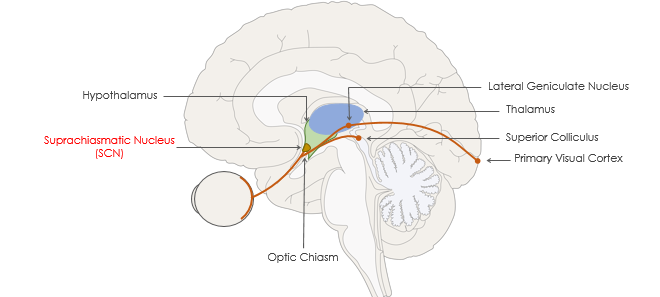Circadian Rhythms and Sleep
1/17
There's no tags or description
Looks like no tags are added yet.
Name | Mastery | Learn | Test | Matching | Spaced |
|---|
No study sessions yet.
18 Terms
Circadian rhythms
24 hour cycle
Endogenous vs Exogenous changes
Endogenous biological clocks (i.e., that are internal to the individual) influence biological rhythms.
Exogenous changes in the environment (i.e., those that are external to the individual) influence biological rhythms.
Internal changes occurring in the circadian cycle
Cortisol (stress hormone) circadian response: Peaks right what you wake up and diminishes through the day and drops and replenishes in sleep
Melatonin circadian response: released by the pineal gland - builds though the day, fluctuates high in sleep, drops right before you wake up
Body temp: Drops at high and rises through the day → rising body temp tells you to wake up
Chronotypes
There are individual differences in this called chronotypes → morning person vs night
Early chronotypes: Wake up energized and get tired as the day goes on
Late chronotypes: Wake up tired and get more energy as the day goes on
This often changes with age: as a kid you are an early chronotype and then you become late and then go back towards early
Should we push school hours to better align with adolesent sleep patterns? - reduces absense (13-16) and better school performance (14-16)
Free running rhythms
Your schedule aligns with natural light exposure → when the sun comes up it resets your clock
so when you take the external signals you would see sleep time would start to shift later and later → too much light would = the opposite
(when we don’t have the circadian cues, our internal clock isn’t actually 24 hours, its longer)

Blindness and circadian rhythm
Unexposed to the sun → insomnia and daytime sleepiness
Your clock isn’t resetting (typically more significant in people who are completely blind (destroyed optic tract or retina)
Can experience a free-running tract
Zeitgebers
Anything in the environment that helps reset the clock and circadian rhythem - Most powerful one is light (resetting SCN)
Others:
Melatonin: sleep onset
Exercise: high intensity in evening can delay next days cercadian cycle
External temp
Mealtime routines
Social influence
Jet lag
Canadian example - phase delay and phase advance
Toronto → Vancouver (west): you lanmd 10pm but 7am vancouver time = phase delay (stay up later) - easier to do
Vancouver → Toronto (east): you land 7pm but 10pm toronto time = phase advance moving the clock forward (harder to do so you stay up late and wake up toronto time tired)
If your going for a short period of time you should try and stay on the time your coming from → better than taking meletonin
Suprachiasmatic Nucleus location, what does it do
located in the hypothalamus above the optic chiasm
Main driver of sleep and body temp rhythms
Just above optic chiasm.
Generates circadian rhythms automatically, even if in cell culture isolated from the rest of the body.
Vision pathway responsible for jet-lag
There are three different pathways collecting info from the retina
Retinal-collicular pathway: One path goes from the retina to the superior colliculus, going to the primary visual cortex
Geniculostriate pathway: Axons from ganglion cells go to the lateral geniculate nucleus, not going to the primary visual cortex; rather, they synapse with different cells around it
Retinohypothalamic Tract: some axons coming from ganglion cells in the retina go off early just above the optic chiasm and activate in SCN involved in regulating circadian rhythms - allowing it to act as a zeitgeber

How does the Retinohypothalamic tract get information
As light comes in, it goes through the ganglion cells, bipolar cells, etc into the rods and cones transducing light that will create a picture
But this isn’t the only way, there are certain kinds of ganglion cells that can also transduce light called Intrinsically Photosensitive Retinal Ganglion Cells (ipRGCs) - this is how it receives info
Intrinsically Photosensitive Retinal Ganglion Cells (ipRGCs)
Ganglion cells that have opsins able to transduce light energy into ion formation
contain the pigment melanopsin and respond directly to light. Light resets the SCN via these ganglion cells
Different types of Intrinsically Photosensitive Retinal Ganglion Cells (ipRGCs)
M1: Non-image-forming → axons done help us make an image they send axons to SCN and convey how much light is coming in (not ab shapes or objects) → THIS IS WHAT RESETS THE SCN
M3: Not sure what they do
M2, M3, M4: Image forming: gives info about light contrasts → some going to the superior colliculus
What would happen to SCN if it was taken out of the brain
They would still be able to keep time
How does a cell function as a clock
per & tim genes transcribed into per & tim mRNA
per & tim mRNA translated into PER & TIM proteins (slowly at first)
PER & TIM inhibit per & tim genes, ↓ transcription of per & tim mRNA
with ↓ PER & TIM, ↓ inhibition of per & tim genes, and cycle repeats
Light triggers a breakdown of TIM
Genes are transcribed into proteins and as those proteins start to accumulate, they inhibit the transcription of genes and fewer proteins are produced = less inhibition on the genes which makes them start to produce more